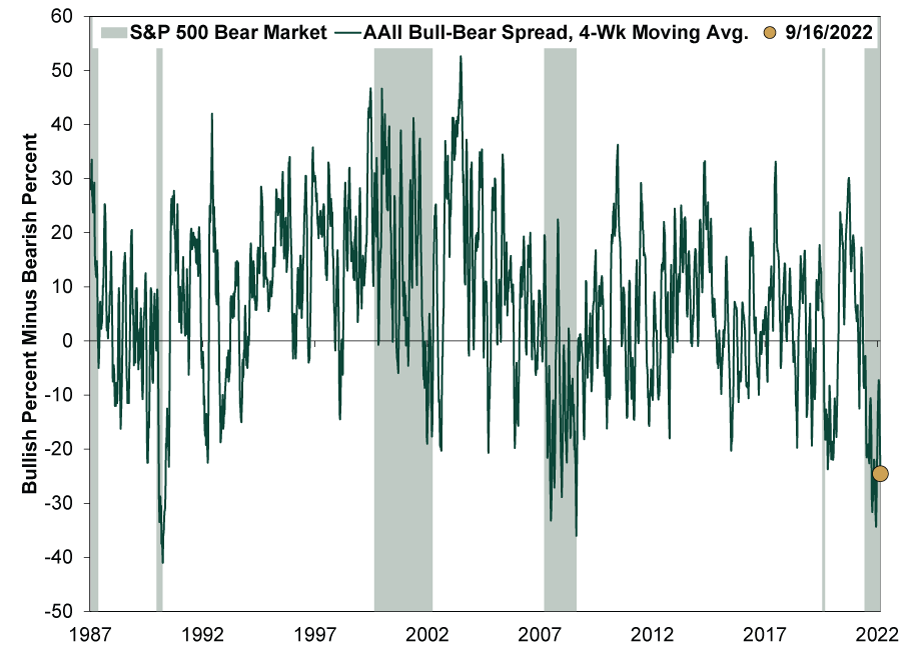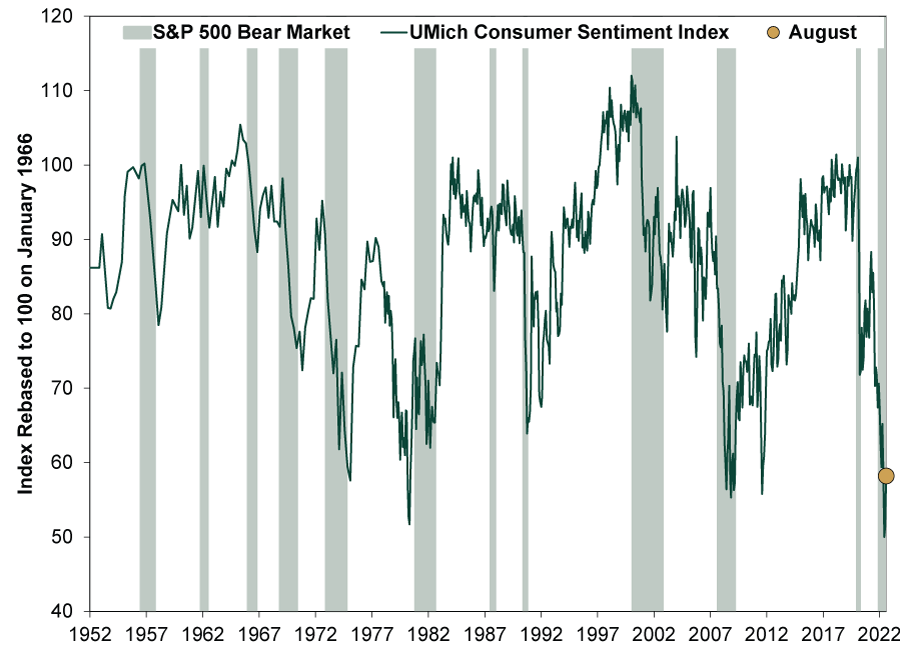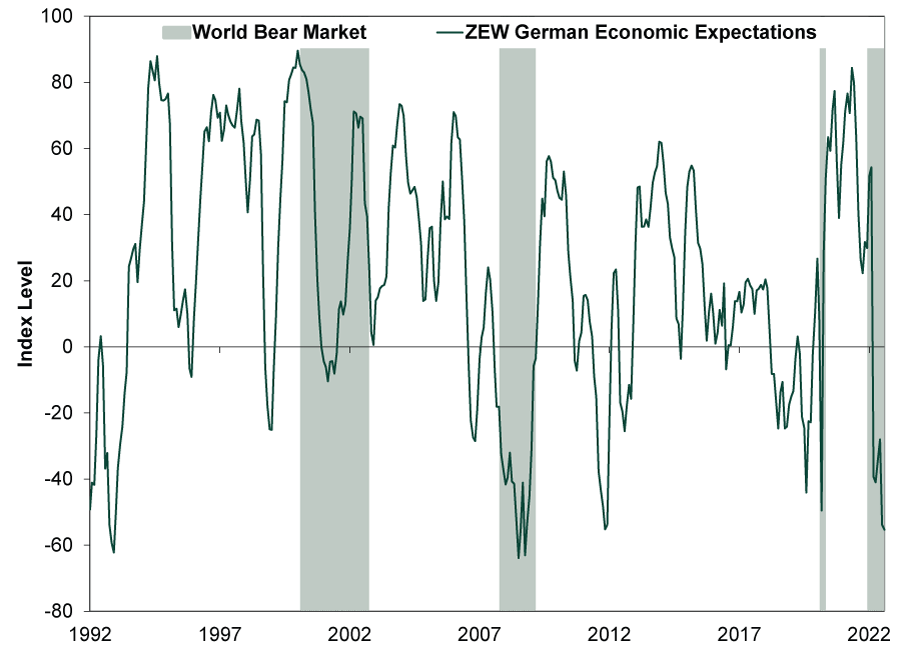Personal Wealth Management / Market Analysis
An End-of-Summer Sentiment Check-In
Sentiment globally is hitting pessimistic extremes.
Nine months into stocks’ slump, the latest downdraft has many on edge—and expecting the worst. That is understandable given the disappointing and difficult year. But, although it can be hard to appreciate in the moment, history shows bull markets are born on pessimism—and recent surveys suggest bearishness is at an extreme. This doesn’t pinpoint when a recovery will begin or whether it is already underway—nothing does—but we see widespread pessimism as a reason for optimism.
Bank of America’s (BofA) widely watched global fund manager survey showed broad bearishness in September. The latest reading indicated the majority of respondents are underweight equities for the first time on record.[i] Now, records start in 2002, so it isn’t an especially long history, but it does include 2007 – 2009’s bear market (typically a prolonged and fundamentally driven decline exceeding -20%) and early-2020’s brief downturn for comparison. Similarly, 62% of managers are overweight cash—a reading that has never been above 60% in two decades. Also notable: 72% expect the global economy to weaken in the next year, with 68% seeing recession likely.[ii] Both rates are near all-time highs, exceeded by only March 2009 and April 2020. The earnings outlook is even glummer with 92% expecting a profits downturn.
BofA’s survey reflects professional investors’ attitudes—what large money managers are thinking and (presumably) doing. But the American Association of Individual Investors’ (AAII) polling suggests individual investor sentiment is similar. AAII surveys its members weekly about their portfolio positioning: bullish, bearish or neutral. Combining them, AAII subtracts the bearish from the bullish, resulting in its net bull-bear percentage. This bull-bear spread can be very noisy week to week, so to smooth it out a bit, Exhibit 1 shows the four-week moving average. Although off its summer trough that coincided with the S&P 500’s June 16 year-to-date low, it remains below nearly all points in its 35-year history. While it isn’t so surprising individual investors are feeling dour, the extent is rather remarkable.
Exhibit 1: Individual Investors Remain Remarkably Bearish
Source: FactSet, as of 9/19/2022. AAII Bull-Bear Market Spread, 7/31/1987 – 9/16/2022.
For a longer-term look at how pessimistic people are, we can also check in on consumers’ feelings, broadening sentiment perspectives beyond investors. As Exhibit 2 shows, through its seven-decade history, the University of Michigan’s (UMich) Consumer Sentiment Index hit an all-time low in June, around the time national average gas prices hit a record high $5.02 per gallon.[iii] With prices at $3.68 per gallon currently, it appears pump prices’ drop has provided some relief. But consumer sentiment under 60 is still extremely low historically. From stocks to the economy, long-running surveys—through myriad market cycles—suggest folks feel about the worst they have ever been.
Exhibit 2: Consumer Sentiment About as Pessimistic as It Gets
Source: FactSet, as of 9/19/2022. UMich Consumer Sentiment Index, January 1952 – August 2022.
It isn’t just true in America, either. Take Germany’s ZEW Economic Expectations Index as an example.[iv] Over the past 30 years, the outlook for the German economy has rarely been as bad as economists saw this past August. (Exhibit 3) The only times worse: 2008’s global financial crisis and in 1992, when hot inflation led the Bundesbank to jack up rates.
Exhibit 3: Economists Expecting the Worst in Germany
Source: FactSet, as of 9/19/2022. ZEW German Economic Expectations, January 1992 – August 2022.
Yet when investors, consumers and economists’ moods alike are plumbing depths not seen in decades—if ever—it helps set the stage for a market recovery. It isn’t a precise timing tool, of course. Nothing is—short-term moves are unpredictable. But near-universal bearishness does set the stage for expectations undershooting reality to a great degree. When everyone expects the worst, it is probably priced in to a large extent, in our view. If the worst happens, stocks can move on. And if that feared scenario doesn’t occur? Typically, the positive surprise drives stocks higher.
[i] “BofA Survey Shows Investors Fleeing Equities En Masse on Fear of Recession,” Sagarika Jaisinghani, Bloomberg, 9/13/2022.
[ii] “Portfolio Managers Are ‘Super Bearish’ With Cash Holdings Highest Since 9/11, Bank of America Says,” Barbara Kollmeyer, MarketWatch, 9/13/2022.
[iii] Source: AAA, as of 9/19/2022.
[iv] ZEW stands for Zentrum für Europäische Wirtschaftsforschung, which if you are wondering means Center for European Economic Research.
If you would like to contact the editors responsible for this article, please message MarketMinder directly.
*The content contained in this article represents only the opinions and viewpoints of the Fisher Investments editorial staff.
Get a weekly roundup of our market insights
Sign up for our weekly e-mail newsletter.

You Imagine Your Future. We Help You Get There.
Are you ready to start your journey to a better financial future?

Where Might the Market Go Next?
Confidently tackle the market’s ups and downs with independent research and analysis that tells you where we think stocks are headed—and why.








